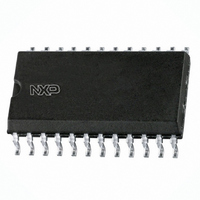74HCT4059D,112 NXP Semiconductors, 74HCT4059D,112 Datasheet - Page 2

74HCT4059D,112
Manufacturer Part Number
74HCT4059D,112
Description
IC PROG DIVIDE-BY-N COUNT 24SOIC
Manufacturer
NXP Semiconductors
Series
74HCTr
Datasheets
1.74HCT4046ADB112.pdf
(19 pages)
2.74HCT4046ADB112.pdf
(23 pages)
3.74HCT4059D112.pdf
(20 pages)
Specifications of 74HCT4059D,112
Package / Case
24-SOIC (7.5mm Width)
Logic Type
Divide-by-N
Direction
Down
Number Of Elements
1
Number Of Bits Per Element
16
Reset
Asynchronous
Timing
Synchronous
Count Rate
36MHz
Trigger Type
Positive Edge
Voltage - Supply
4.5 V ~ 5.5 V
Operating Temperature
-40°C ~ 125°C
Mounting Type
Surface Mount
Counter Type
Decade Counters
Logic Family
74HCT
Counting Method
Synchronous
Counting Sequence
Down
Mounting Style
SMD/SMT
Lead Free Status / RoHS Status
Lead free / RoHS Compliant
Lead Free Status / RoHS Status
Lead free / RoHS Compliant, Lead free / RoHS Compliant
Other names
568-2858-5
933757430112
933757430112
Philips Semiconductors
FEATURES
GENERAL DESCRIPTION
The 74HC/HCT4059 are high-speed Si-gate CMOS
devices and are pin compatible with the “4059” of the
“4000B” series. They are specified in compliance with
JEDEC standard no. 7A.
The 74HC/HCT4059 are divide-by-n counters which can
be programmed to divide an input frequency by any
number (n) from 3 to 15 999. There are four operating
modes, timer, divide-by-n, divide-by-10 000 and master
preset, which are defined by the mode select inputs (K
K
Function table.
The complete counter consists of a first counting stage, an
intermediate counting stage and a fifth counting stage. The
first counter stage consists of four independent flip-flops.
Depending on the divide-by-mode, at least one flip-flop is
placed at the input of the intermediate stage (the remaining
flip-flops are placed at the fifth stage with a place value of
thousands). The intermediate stage consists of three
cascaded decade counters, each containing four flip-flops.
All flip-flops can be preset to a desired state by means of
the JAM inputs (J
(CP) will cause all stages to count from n to zero. The
zero-detect circuit will then cause all stages to return to the
JAM count, during which an output pulse is generated. In
the timer mode, after an output pulse is generated, the
output pulse remains HIGH until the latch input (LE) goes
LOW. The counter will advance, even if LE is HIGH and
the output is latched in the HIGH state.
1998 Jul 08
c
Synchronous programmable divide-by-n counter
Presettable down counter
Fully static operation
Mode select control of initial decade counting function
(divide-by-10, 8, 5, 4 and 2)
Master preset initialization
Latchable output
Easily cascadable with other counters
Four operating modes:
timer
divider-by-n
divide-by-10 000
master preset
Output capability: standard
I
) and the latch enable input (LE) as shown in the
Programmable divide-by-n counter
CC
category: MSI
1
to J
16
), during which the clock input
a
to
2
In the divide-by-n mode, a clock cycle wide pulse is
generated with a frequency rate equal to the input
frequency divided by n.
The function of the mode select and JAM inputs are
illustrated in the following examples. In the divide-by-2
mode, only one flip-flop is needed in the first counting
section. Therefore the last (5th) counting section has three
flip-flops that can be preset to a maximum count of seven
with a place value of thousands. This counting mode is
selected when K
is used to preset the first counting section and J
used to preset the last (5th) counting section.
If the divide-by-10 mode is desired for the first section, K
and K
J
is no last counting section). The intermediate counting
section consists of three cascaded BCD decade
(divide-by-10) counters, presettable by means of the JAM
inputs J
The preset of the counter to a desired divide-by-n is
achieved as follows:
n = (MODE
To calculate preset values for any “n” count, divide the “n”
count by the selected mode. The resultant is the
corresponding preset value of the 5th to the 2nd decade
with the remainder being equal to the 1st decade value;
preset value = n/mode.
If n = 8 479, and the selected mode = 5, the preset
value = 8 479/5 = 1 695 with a remainder of 4, thus the
JAM inputs must be set as shown in Table 1.
To verify the results, use the given equation:
n = 5 (1 000 1 100 6 10 9 1 5) 4
n = 8 479.
If n = 12 382 and the selected mode = 8, the preset
value = 12 382/8 = 1 547 with a remainder of 6, thus the
JAM inputs must be set as shown in Table 2.
To verify:
n = 8 (1 000 1 100 5 10 4 1 7)
n = 12 382.
(1)
1
to J
MODE = first counting section divider
(10, 8, 5, 4 or 2).
10 x decade 3 preset
1 x decade 2 preset)
decade 1 preset
100 x decade 4 preset
b
4
are set HIGH and K
are used to preset the first counting section (there
5
to J
(1)
16
) (1 000 x decade 5 preset
.
a
to K
c
are set HIGH. In this case input J
c
is set LOW. The JAM inputs
74HC/HCT4059
Product specification
6
2
to J
4
are
1
a















